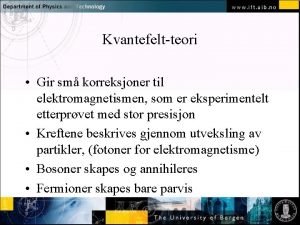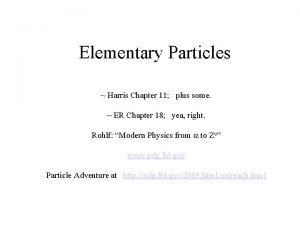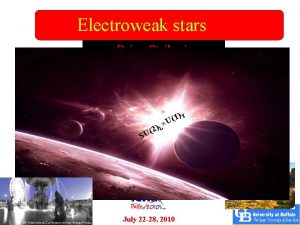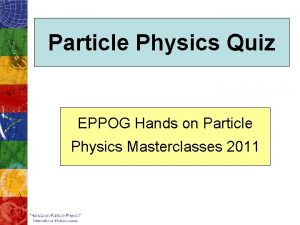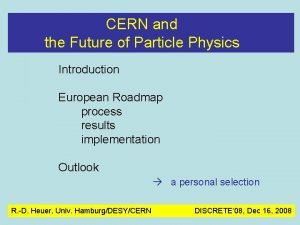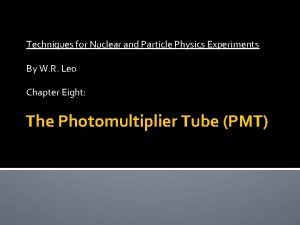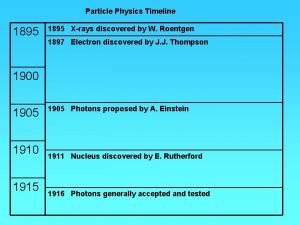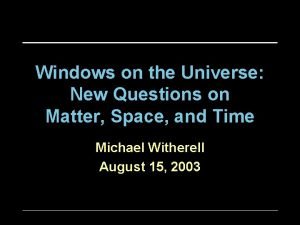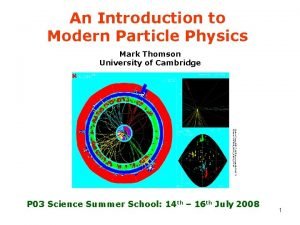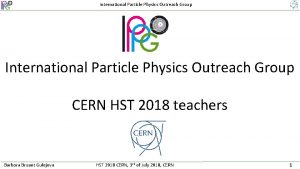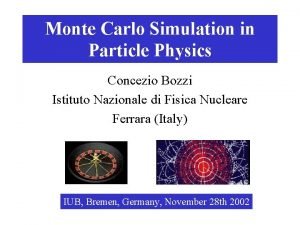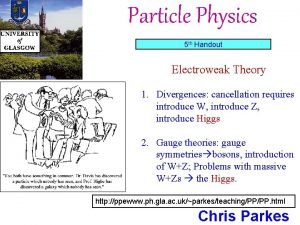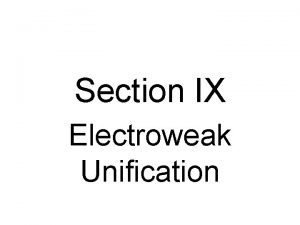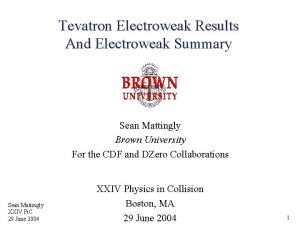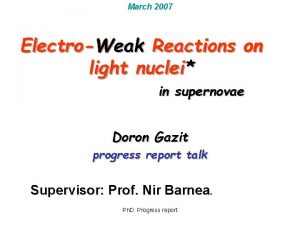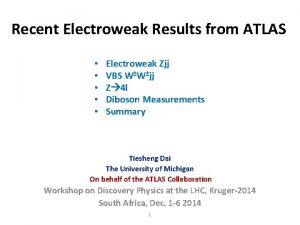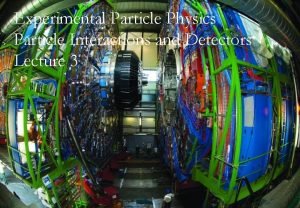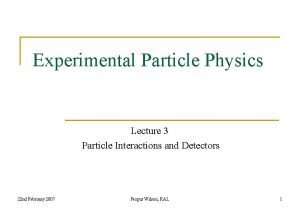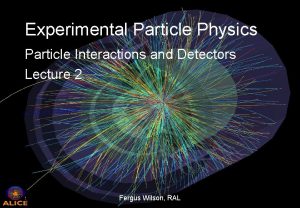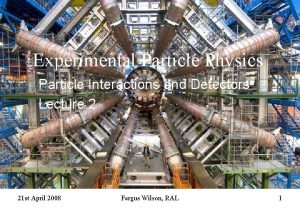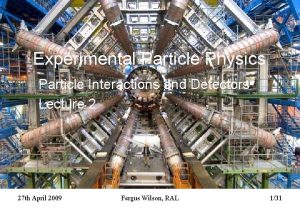Particle Physics II 1 st Handout Experimental electroweak
















- Slides: 16

Particle Physics II 1 st Handout Experimental electroweak physics: W &Z • Resonances • Measuring the number of neutrinos from the width of the Z 0 • W mass & branching ratio Chris Parkes Room 455, chris. parkes@cern. ch

Course Content • Experimental Electroweak: W & Z – Number of generations from Z resonance – Triple boson vertices • Top Quark & Higgs – Direct & indirect searches • Heavy Flavour Physics – Flavour changing interactions • CP Violation – matter anti-matter asymmetry • Beyond the Standard Model – Neutrinos – Supersymmetry – Astro-particle physics Text books: 1. Alessandro Bettini, Introduction to Elementary Particle Physics, Cambridge University Press (2008) 2. B. R. Martin and G. Shaw, Particle Physics (2 nd edition), Wiley (2001) 3. Donald H. Perkins, Introduction to High Energy Physics (4 th edition), Cambridge University Press (2000).

Resonances and particles • Many particles are too short-lived to be observed directly – Observe from decay particles – e. g. pp X+other stuff, X µ+µ- Three resonances =2ΔE FWHM Energy uncertainty ΔE is known as the particles width . Uncertainty principle relates width and mean lifetime τ of particle Exponential decay process for particles 3

Particle Width/lifetime Depends on: • Strength of interaction • Strong G~10 -100 Me. V t~10 -22 -10 -24 s • EM G~10 -100 ke. V t~10 -16 -10 -20 s • Weak G<0. 01 e. V t~10 -8 -10 -13 s • Number of different states the particle can decay into • Can see long-lived particle through their decay distance • Can see short-lived particles through their width Shorter lifetime, larger width STRONG EMAG WEAK Flight distance 4

Breit-Wigner • The total width is related to the strength of the interaction • The particle can usually decay to A number of different final states • Each individual decay mode has a width, i, such that sum of “partial widths”=total width. • Branching Ratio • Fraction of decays to that state • BR= i/ • Total width from width of invariant mass distribution • Mass from centre of distribution • Partial width of initial and final states from height of distribution • Shape is same for all decays spins Energy

Z 0 production • e+e- has two diagrams g and Z 0 exchange • Photon exchange dominates at low c. m. energies • Z 0 exchange results in a resonance at Mz • At High cm energy, both photon and Z exchange – EW unification • Calculation of relative strength of xsection 6

Much Ado about Nothing: Getting Nn from Z Final states X in Zdecays Counting states e= m= t l Total width from shape in any decay channel ne= nm= nt n Partial widths from all seen decay channels u= c u What isn’t seen is the neutrinos had d= s= b d Z= had+3 l+Nn n How to get Nn

Number of neutrinos • Mass – peak of distribution – MZ=91. 1876± 0. 0021 Ge. V (0. 02% error!) • Total width - width Z=2. 4952± 0. 0023 Ge. V (0. 1%) • Partial Widths – number events had=1. 741± 0. 006 l=0. 0838± 0. 0003 • Neutrino width from theory – determine number • Nn=2. 97± 0. 07 LEP

What does it mean? • Proves there are only three generations of particles • 3 neutrino families 3 generations – Satisfies anomaly condition • What is the catch? – Assumed neutrinos massless in theory width – Neutrinos now know to have mass (more later) but very small – Mass hierarchy Z 0 • We have summed Z X+XIf there is an extra neutrino X With mass > Z mass/2 Z could not decay to it 9

How is Z mass / lineshape reconstructed ? • Energy of electron&positron beams in accelerator adjusted • Cross-section measured at different energies • Breit-wigner fitted to cross-sections Peak value gives mass

Aside: Measuring the LEP beam energy TRAINS The accuracy with which the LEP beam energy is known controls the accuracy of MZ Return current for train –TGVchanged magnet currents TIDE Tidal effects change the shape of the ring TIDE

W Discovery • UA 1, UA 2 1983 • Proton anti-proton collider • W e-+ν • Lots of soft tracks + electron ‘transverse’ mass E 2 -p 2, taking only components In transverse plane

LEP e+e- W+W • Can be used to make precision tests of electroweak theory Recall: 3 diagrams contribute First Event: Me et al. !

Demonstration of triple boson vertex • All three diagrams contribute and interference • Total cross-section agrees with theory, requires Triple boson vertex 14

W boson: mass measurement How: • Measure momentum of all charged particles Why: • Test of SM, recall – Highly relativistic E≈p • Energy of neutrals in calorimeters – Less well measured than p • Cluster particles into jets • Allows measure top mass, higgs mass in SM – See later – Obtain quark momenta • ‘Missing’ momenta – Gives neutrino • Pair jets/leptons – Form W • Reconstruct mass from – E 2 -p 2=m 2 • Use known constraints to improve – Total energy from beams – Total momentum=0 15

W boson: branching fractions • Count possible decays of W • Leptonic: • Hadronic: Not as too heavy [Hadronic is approximation – discuss CKM matrix later] – but 3 colours • 3 leptonic+2 hadronic *3 colours =9 states – Approx 1/9 B. R per state – 6/9= 67% hadronic • Width per state =225 Me. V – Total width W=9*225 Me. V~2 Ge. V Q)What is lifetime ? Q)What fraction e+e- W+W are fully hadronic/leptonic/mixed decays? Which can be used for mass measurement ? 16
 Electroweak interaction
Electroweak interaction Electroweak interaction
Electroweak interaction Dejan stojkovic physics
Dejan stojkovic physics Standard model lagrangian
Standard model lagrangian Research approaches and designs
Research approaches and designs Experimental vs non experimental research
Experimental vs non experimental research Experimental vs non experimental
Experimental vs non experimental Experimental vs non experimental
Experimental vs non experimental Nonexperimental study
Nonexperimental study Particle physics practice quiz
Particle physics practice quiz Cern particle physics
Cern particle physics Pmt particle physics
Pmt particle physics Particle physics timeline
Particle physics timeline Particle physics
Particle physics Mark thomson modern particle physics
Mark thomson modern particle physics Cern particle physics
Cern particle physics Monte carlo simulation particle physics
Monte carlo simulation particle physics
